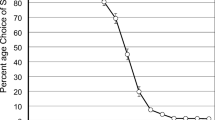Abstract
Four hundred college students received one of five sequences in which one of two events occurred on either 60%, 70%, 80%, 90%, or 95% of 100 trials followed by 30 trials during which one event was always correct. A partial reinforcement hump—a rise and decline in the dependent variable curve following partial reinforcement—appeared in the postacquisition curves of two of the five groups. In the other three groups, a large fall-off in the curve occurred where a large drop in the curve should occur if postacquisition choices are controlled by the cognitive processes posited to produce the partial reinforcement hump. These results are consistent with the general expectancy position.
Similar content being viewed by others
References
ATKINSON, J. W. (1957). Motivational determinants of risk-taking behavior. Psychological Review, 64, 359–372.
BANDURA, A. (1977). Self-efficacy: Toward a unifying theory of behavioral change. Psychological Review, 84, 191–215.
BOLLES, R. C. (1972). Reinforcement, expectancy, and learning. Psychological Review, 60, 360–370.
CAPALDI, E. J. (1966). Partial reinforcement: An hypothesis of sequential effects. Psychological Review, 73, 459–477.
CARVER, C. S., & SCHEIER, M. F. (1981). Attention and self-regulation: A control-theory approach to human behavior. New York: Springer-Verlag.
DETAMBEL, M. H. (1950). A reanalysis of Humphreys’ “Acquisition and extinction of verbal expectations.” Unpublished master’s thesis, Indiana University, Bloomington.
ESTES, W. K. (1972). Research and theory on the learning of probabilities. Journal of the American Statistical Association 67, 81–102.
ESTES, W. K. (1976). The cognitive side of probability learning. Psychological Review, 83, 37–64.
HARTLEY, R. E., & WILLIAMS, C. D. (1982). Prolegomenon to cognitive learning theory. Interdisciplinaria, 3, 101–132.
HARTLEY, R. E., & WILLIAMS, C. D. (1984). Confirmation learning theory. Manuscript submitted for publication.
HUMPHREYS, L. G. (1939a). The effect of random alternation of reinforcement on the acquisition and extinction of conditioned eyelid reactions. Journal of Experimental Psychology, 25, 141–158.
HUMPHREYS, L. G. (1939b). Acquisition and extinction of verbal expectations in a situation analogous to conditioning. Journal of Experimental Psychology, 25, 294–301.
HUMPHREYS, L. G. (1940). Extinction of conditioned psycho-galvanic responses following two conditions of reinforcement. Journal of Experimental Psychology, 27, 71–75.
JENKINS, W. O., & STANLEY, J. C., Jr. (1950). Partial reinforcement: A review and critique. Psychological Bulletin, 47, 193–234.
JONES, M. R. (1971). From probability learning to sequential processing: A critical review. Psychological Bulletin, 76, 153–185.
LEWIN, K., DEMBO, T., FESTINGER, L., & SEARS, P. S. (1944). Level of aspiration. In J. McV. HUNT (Ed.), Personality and the behavior disorders (Vol. 1, pp. 333–378). New York: Ronald Press.
LEWIS, D. J. (1960). Partial reinforcement: A selective review of the literature since 1950. Psychological Bulletin, 57, 1–28.
MAIER, S. F., & SELIGMAN, M. E. P. (1976). Learned helplessness: Theory and evidence. Journal of Experimental Psychology: General, 105, 3–46.
MISCHEL, W. (1973). Toward a cognitive social learning reconceptualization of personality. Psychological Review, 80, 252–283.
MYERS, J. L. (1970). Sequential choice behavior. In G. H. BOWER & J. T. SPENCE (Eds.), The psychology of learning and motivation: Advances in research and theory (Vol. 4, pp. 109–170). New York: Academic Press.
MYERS, J. L. (1976). Probability learning and sequence learning. In W. K. ESTES (Ed.), Handbook of learning and cognitive processes: Vol. 3. Approaches to human learning and motivation (pp. 171–205). Hillsdale, NJ: Lawrence Erlbaum Associates.
ROBBINS, D. (1971). Partial reinforcement: A selective review of the alleyway literature since 1960. Psychological Bulletin, 76, 415–431.
ROTTER, J. B. (1954). Social learning and clinical psychology. Englewood Cliffs, NJ: Prentice-Hall.
SHIBA, S. (1964). A model for positive and negative recency effects on predictive behavior. Japanese Psychological Research, 6, 46–52.
TOLMAN, E. C. (1932). Purposive behavior in animals and men. New York: Appleton-Century-Crofts.
WILLIAMS, C. D., & HARTLEY, R. E. (1982). Humphreys’ “Acquisition and extinction of verbal expectations” revisited: Evidence for a partial reinforcement hump effect. Psychological Reports, 51, 1023–1034.
Author information
Authors and Affiliations
Rights and permissions
About this article
Cite this article
Hartley, R.E., Williams, C.D. The Partial Reinforcement Hump in A Two-Choice Sequential Prediction Task With Alternatives of Unequal Frequency. Psychol Rec 35, 391–399 (1985). https://doi.org/10.1007/BF03395860
Published:
Issue Date:
DOI: https://doi.org/10.1007/BF03395860




